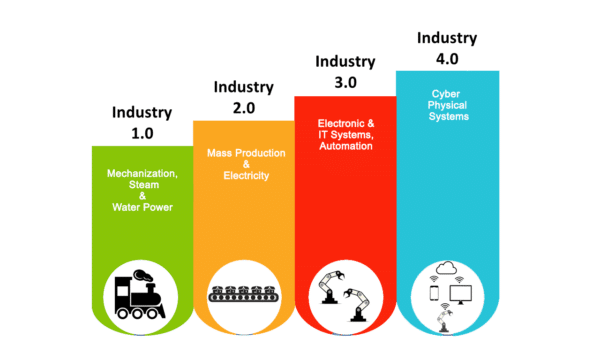Top 10 Skills You Need to Thrive in the 4th Industrial Revolution
A constantly changing world requires adaptable skills to meet the needs of the hour. The need for highly specialized skills has driven today’s workforce into developing and honing new skills.
If you find yourself in between jobs or seeking to improve your current skills, this article offers you actionable tips to guide you. Also, you will be getting insights into the top 10 skills that are relevant in the fourth industrial revolution.
Table of Contents
What Is The Fourth Industrial Revolution (4IR)?
The fourth industrial revolution is an era that characterizes the combination of biological, digital, and physical worlds in the automation of production.
The fourth industrial revolution was first proposed by Klaus Schwab (Chairman, the World Economic Forum), in which he described prevailing technologies of the era. Technologies that will drive the fourth industrial revolution include artificial intelligence (AI), the Internet of Things (IoT), cloud computing, and nanotechnology. Others are 3D printing, robotics, blockchain technology, and quantum computing. It is an era preceded by the first, second, and third industrial revolutions.
To understand how we got to the fourth, we will need to take a peek into its predecessors.

Also read Top 20 Technology Skills You Need Today and Where to Learn Them
First Industrial Revolution
The first industrial revolution represents an era that marked the change from an agriculture-based to a production-based economy. Recorded to have started in Great Britain from the late 18th century to the middle 19th century, the first revolution ushered in the use of steam power and water power for production.
Other features that characterized the first revolution were the use of steel, iron, and such energy sources as coal, electricity, the steam engine, and petroleum.
Second Industrial Revolution
The Second Industrial Revolution typified a period of technological revolution around the late 19th to early 20th centuries.
It was an era when mass production was made possible due to advancements in product line technology. This made it possible for the mass employment of factory workers and a major increase in the number of middle-class workers.
Third Industrial Revolution
The third industrial revolution witnessed the use of electronics, computers, information technology, and telecommunications for automating production. Beginning in the mid-20th century, the successes recorded in this era served as a precursor to the fourth industrial revolution.
Now that we have a basic understanding of their strengths, let’s highlight the top 10 skills that are likely to sell in the fourth industrial revolution.
Top 10 Skills in the 4th Industrial Revolution
1: Active Listening
Active listening is a soft skill that is expressed in those who pay particular attention to what they are being told. This is a vital skill that helps to enhance communication between employees and employers, between parents and children, or between teachers and students.
Active listening, like every other skill, requires time and practice to become proficient. If developed, active listening offers benefits such as trust-building, rapport, and expressing empathy. Just like other skills, active listening is a skill that you can develop and improve upon.
Here are some techniques that can help you improve your listening.
- Consciously listening to the other person: Most people do not focus their entire attention when listening to someone else. On a scale of 1 to 10, I’ll give the average person 4.
Why’s that?
That’s because a lot of people are preoccupied with their thoughts when listening to others. However, practicing active listening with a focus on the other person can lead to improvements.
- Listen to what is said and what is unsaid. Communication isn’t only about words, as voice tone, pitch, loudness, and body movements are also used to communicate. To improve your listening ability, listen to what is being said and how the other person says it.
- Always acknowledge statements made by the speaker. This is a form of feedback that lets the speaker know that she has been heard and understood.
- Wait for the speaker to finish making her statement before you respond. Avoid interrupting the speaker unless it is necessary to do so.
- Offer appropriate responses when it is your turn to speak.
Also read Top 20 Entrepreneurship Skills You Should Have—Future Skills
2: Complex problem solving
The fourth industrial revolution is replete with sophisticated products and services and a rapidly changing environment.
You find that success in the marketplace requires the ability to solve complex problems.
Regarded as one of the most vital skills for today’s workforce, complex problem-solving abilities enable workers to respond swiftly to corporate threats. Not just that but also responses that help managers handle large sets of data and information as well as technological and human issues.
Although artificial intelligence (AI) is used by firms to gather and analyze large chunks of data, such systems have their limits. Some situations require the use of complex problem-solving capabilities to solve.
Much like other skills, developing complex problem abilities requires you to follow a standard process plus plenty of practice.
These 4 steps are quite simple but very effective for solving complex problems.
- Problem definition: This step is necessary for defining the real problem(s) to be solved. This is where you identify the root cause of the problem. It is easy to get carried away with the symptoms of a problem without finding out the cause. Skills like observation and asking the right questions will help you discover the root cause of the problem.
- Generation of alternatives: After finding out the root cause of the problem, you will have to consider alternatives for solving the problem. If you work as part of a team, then you might opt for brainstorming sessions until the right set of alternatives are generated.
- Evaluation of alternatives: All the alternatives have to be evaluated to get the right solution for the problem. This step is only completed when the best solution is chosen.
- Implementation of solutions: Put the solution to work and ensure to keep records of all observations and results.
3: Coordinating With Others
The ability to coordinate very well is a requisite skill for today’s working professionals. One important concept that best captures the term ‘coordinating with others’ is your ability to work with a team. This is either as the team leader or as a vital member of the team.
Incidentally, most applicants include ‘ability to work with teams’ in their resumes. However, not many can pass the test when they find themselves in uncomfortable situations.
To help with developing your ability to coordinate with others, here are some actionable tips to use.
- Maintain clear communication. How can two people work together effectively if there is no clear communication? That’s a recipe for failure because vague communication will lead to disaster. Ensure that you use terms that other team members understand, and if you’re not sure, ask for feedback from them. Also, there should be a clear line of authority to ensure that everyone knows and understands their positions.
- Get organized. Good organizational skills ensure that problems are resolved at the right time. Team members should also be encouraged to keep their work organized. Give attention to details, organize workload according to ability, be prompt, and respect the time of others. Do this, and you will enjoy a healthy working relationship with team members.
- Add unique value to others. Do not think of what your team will give to you, but think of unique ways of adding value to the team. If you are not able to identify a unique value you are bringing, then you will need to work on yourself first.
- Work with understanding. There are as many different personalities in the world as there are people. To enjoy a great working experience is to understand the unique personalities of those you work closely with and work with them accordingly. If you treat others the way they love to be treated, you will always get the best out of them.
- Put the team first. As far as work is concerned, the interest of the team comes first. Never let your interests conflict with the interests of your team or company.
4: Creativity
Creativity is a top skill that is required for workers to excel in today’s workplace. It is a difficult skill to acquire or learn because there are no standard rules for building creativity. Most of the talented bunch that you see out there were those who were discovered quite early in their lives.
These people then had to go through rigorous training to transform those skills into creative abilities. So when you hear a talented musician or watch a skilled basketball player playing, you are watching countless hours of training and development.
Creativity is also essential in the workplace because it enables thinking outside the box. Even if you do not see yourself as being creative, you can still develop creativity from within you.
These tips can help you become more creative in the workplace.
- Identify any areas in which you are talented. You need to understand that talent isn’t only about knowing how to sing or dance. Talent could be in any field of endeavor that you find yourself engaged in. A talent is anything that you can do better than many other people.
- Practice. The best way to develop creativity is through constant practice. You can engage the services of a coach, friend, or family to help out with your practice sessions.
- Request valuable feedback from those who truly care. If you get positive feedback, it means you’re doing it right. And of course, negative feedback means you have to make changes in certain areas.
- Avoid negative people as much as possible because they stifle creativity with their negativism.
5: Critical thinking
Critical thinking is a skill that enables you to think rationally and clearly about any ideas or information presented to you. It enables you to deduce any consequences before you take the action. It is an ability that is often associated with those who can think reflectively and independently.
Because of the nature of critical thinking, some people hold the view that it is an ability that opposes creativity. This isn’t the case, as creativity is focused on thinking outside the box, while critical thinking is all about understanding the logic behind ideas. That’s why you can develop both creativity and critical thinking abilities.
You can improve your critical thinking ability by developing routines or procedures for responding to situations. The more you can do this effectively, the better you get at critical thinking.
Read Also: 5 Immigrants Tell us the Types of Jobs You Should Avoid Abroad (USA, UK or Canada)
6: Judgment and Decision Making
The primary reason for the existence of businesses is to solve problems for their target markets. They do this by delivering valuable information, products, and services that address the real needs of their market.
However, in the process of solving problems for their customers, businesses also encounter problems of their own. The key to resolving the business’ problems lies in workers who have highly developed judgment and decision-making abilities. That’s the reason why businesses place a high value on workers with judgment and decision-making capabilities.
Highly developed judgment is a skill that is found in people who can make reasonable decisions all the time. This doesn’t mean that there would be no error in judgment, but it does mean that the decision is considered logically before concluding.
That way, there is very little chance of making the wrong call.
Judgment can be improved with constant learning and experience gained on and off the job.
Read Also: How to get loans to study in the USA and Canada
7: Negotiation
This is a process used for settling differences between two or more parties to arrive at a compromise. The idea is to get all negotiating parties to agree with the decision reached.
There are lots of reasons for negotiating between the parties, such as:
- A newly recruited staff member trying to get the best possible working conditions
- Two countries are in armed conflict over a parcel of land.
- A mother negotiates with her daughter on certain terms that have to do with the home.
Negotiation is a skill that can be honed and developed by just about anyone. All that is required is to develop a negotiation plan that you will follow anytime the need arises.
Here are action steps to take for fine-tuning your negotiation strategies and skills.
- Making preparations: the first step for effective negotiation is to decide on the goal you intend to achieve. Also, you have to determine the particular location where the negotiation will be taking place. How many people are you expecting your counterparty to bring to the table? These and many other related questions will need to be answered by you before taking the next step.
- The interest of the other party. The other party to the negotiation certainly needs something from you or your company. You have to know what it is they are expecting from you or your company and also find out if other interests haven’t been indicated yet.
- Alternatives that you may allow or propose. Negotiations don’t always go in a straight line; in fact, they rarely do. You have to consider what other options to propose just in case it isn’t going your way.
- At what point are you willing to agree to the negotiation terms? This should be at the back of your mind and that of your negotiation team. Also, your team has to agree on when to end the negotiation if they do not like the terms.
Also read Top 5 Negotiation Skills You Should Master as an Entrepreneur
8: People Management
Aspiring for a management position in your present office or a new company? Or maybe you have been assigned to head a small team of workers at your workplace. Then you need to be effective at managing people or at least have a plan for developing the ability.
People management involves the process of nurturing, motivating, and inspiring employees to give their best every time. If well done, people management can help to optimize productivity and enhance efficiency at the workplace.
People management also entails talent acquisition, optimization, and retention.
To be effective at this, you should have a systemized set of practices or strategies to follow. If your company doesn’t already have this, you can develop a personal action plan for managing your people.
Here are some of the items that should be in your people management strategy:
- Have one-on-one sessions with members of your team at least once a week (each session should last a minimum of 30 minutes)
- Develop and show sincere interest in the welfare of your team.
- Develop training programs that will build up the capacity of your team members.
- Maintain an open-door policy to encourage feedback from them.
- Be at the forefront; in other words, lead by example.
9: Quality Control
We’re living in an era when consumers have access to product information like never before. An average consumer will research several different platforms before deciding on a vendor to purchase from.
One of the things that consumers look for in products is the quality of products that they buy. And because they have the needed product information through research, consumers can tell if a business’ products meet their expectations.
However, businesses have to ensure that their products or services comply with the specifications earlier advertised. Quality control is a system or process that is put in place by businesses to check the quality of what they produce. It is in charge of reviewing all the factors that are involved in the business’ production process.
Quality control also comprises checks on controls, managed processes, performance, and integrity of the process. The quality control inspector is the person in charge of monitoring all activities under the purview of the quality control department or unit.
Quality control inspectors are fit to work in almost all industries as long as there are employment offers for qualified persons.
Also read 13 Recommended Not-totally Free Online Courses on Coursera
10: Service Orientation
Service orientation is a business function that is designed to anticipate and deliver an optimum experience to customers. Rather than focusing on supporting services that a business offers, service orientation is focused on giving the best quality of its core service. A business that can deliver an optimum user experience will never have trouble differentiating itself in the marketplace.
A service-oriented company puts its customers first, even before sales or profits. You will also find out that such businesses offer high-quality customer support systems. To ensure that your company always takes the right path towards service orientation, let your customers be your main focus, educate them, and find out how helpful your services are.
Also, seek to identify different pain points that your customers experience and creative solutions to meet each of the pain points. Service orientation is also an attitude that employees can have at their offices.
Watch these 5 IMPORTANT WAYS JOBS WILL CHANGE IN THE 4TH INDUSTRIAL REVOLUTION.
Tap here to watch
In conclusion, we are living in a fast-paced world where everything seems to be changing at the speed of light. There have been a series of industrial revolutions that mark significant changes in man’s production capabilities. These industrial revolutions include the first revolution, which was characterized by the use of steam and water power to mechanize production.
The Second Industrial Revolution typified an era where mass production, railroads, gas, electricity, and factory jobs were the mainstay. The third industrial revolution featured the use of electronics, nuclear energy, computers, and telecommunications to automate production.
The fourth industrial revolution presents an era where we witness the combination of physical, digital, and biological worlds for production automation. Relevant technologies present in the fourth industrial revolution include Artificial Intelligence, blockchain, the Internet of Things, and nanotechnology.
Also read 7 Industries Most Likely to Make You a Millionaire Today
This post offers the top skills that you require to thrive in the fourth industrial revolution.









